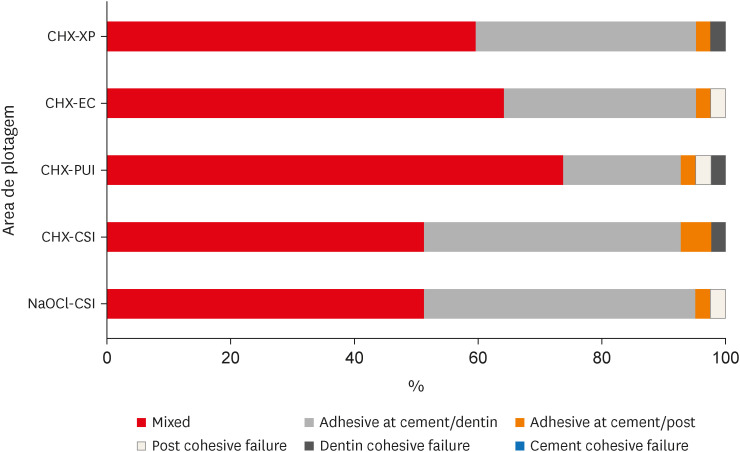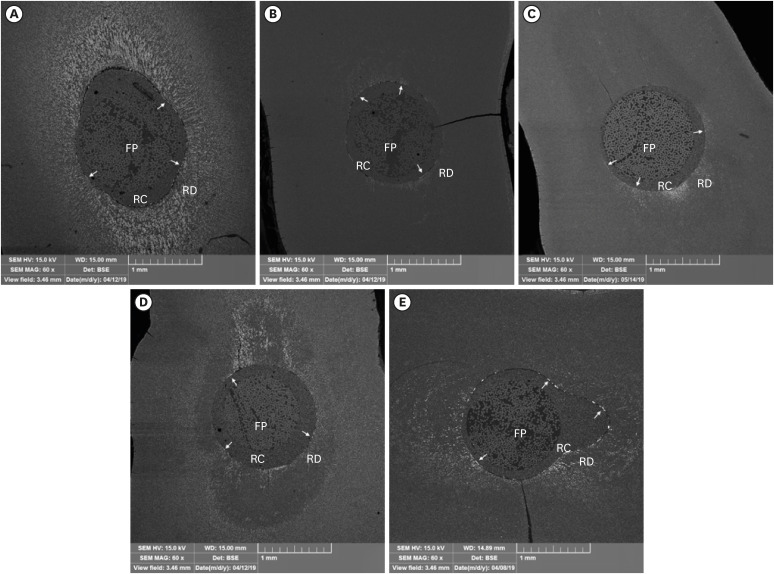1. Tian Y, Mu Y, Setzer FC, Lu H, Qu T, Yu Q. Failure of fiber posts after cementation with different adhesives with or without silanization investigated by pullout tests and scanning electron microscopy. J Endod. 2012; 38:1279–1282. PMID:
22892751.

2. Faria-e-Silva AL, Menezes MS, Silva FP, Reis GR, Moraes RR. Intra-radicular dentin treatments and retention of fiber posts with self-adhesive resin cements. Braz Oral Res. 2013; 27:14–19. PMID:
23306622.

3. Ferracane JL, Stansbury JW, Burke FJ. Self-adhesive resin cements - chemistry, properties and clinical considerations. J Oral Rehabil. 2011; 38:295–314. PMID:
21133983.

4. Gomes GM, Gomes OM, Reis A, Gomes JC, Loguercio AD, Calixto AL. Regional bond strengths to root canal dentin of fiber posts luted with three cementation systems. Braz Dent J. 2011; 22:460–467. PMID:
22189640.

5. Vichi A, Grandini S, Davidson CL, Ferrari M. An SEM evaluation of several adhesive systems used for bonding fiber posts under clinical conditions. Dent Mater. 2002; 18:495–502. PMID:
12191661.

6. Kul E, Yeter KY, Aladag LI, Ayrancı LB. Effect of different post space irrigation procedures on the bond strength of a fiber post attached with a self-adhesive resin cement. J Prosthet Dent. 2016; 115:601–605. PMID:
26774312.

7. Monticelli F, Osorio R, Mazzitelli C, Ferrari M, Toledano M. Limited decalcification/diffusion of self-adhesive cements into dentin. J Dent Res. 2008; 87:974–979. PMID:
18809754.

8. Hayashi M, Takahashi Y, Hirai M, Iwami Y, Imazato S, Ebisu S. Effect of endodontic irrigation on bonding of resin cement to radicular dentin. Eur J Oral Sci. 2005; 113:70–76. PMID:
15693832.

9. Angeloni V, Mazzoni A, Marchesi G, Cadenaro M, Comba A, Maravi T, Scotti N, Pashley DH, Tay FR, Breschi L. Role of chlorhexidine on long-term bond strength of self-adhesive composite cements to intraradivular dentin. J Adhes Dent. 2017; 19:341–348. PMID:
28849803.
10. Barreto MS, Rosa RA, Seballos VG, Machado E, Valandro LF, Kaizer OB, Só M, Bier C. Effect of intracanal irrigants on bond strength of fiber posts cemented with a self-adhesive resin cement. Oper Dent. 2016; 41:e159–e167. PMID:
27603176.

11. Alkhudhairy FI, Yaman P, Dennison J, McDonald N, Herrero A, Bin-Shuwaish MS. The effects of different irrigation solutions on the bond strength of cemented fiber posts. Clin Cosmet Investig Dent. 2018; 10:221–230.

12. Seballos VG, Barreto MS, Rosa RA, Machado E, Valandro LF, Kaizer OB. Effect of post-space irrigation with NaOCl and CaOCl at different concentrations on the bond strength of posts cemented with a self-adhesive resin cement. Braz Dent J. 2018; 29:446–451. PMID:
30517442.

13. Lindblad RM, Lassila LV, Salo V, Vallittu PK, Tjäderhane L. Effect of chlorhexidine on initial adhesion of fiber-reinforced post to root canal. J Dent. 2010; 38:796–801. PMID:
20600556.

14. Lührs AK, Guhr S, Günay H, Geurtsen W. Shear bond strength of self-adhesive resins compared to resin cements with etch and rinse adhesives to enamel and dentin
in vitro
. Clin Oral Investig. 2010; 14:193–199.

15. Durski M, Metz M, Crim G, Hass S, Mazur R, Vieira S. Effect of chlorhexidine treatment prior to fiber post cementation on long-term resin cement bond strength. Oper Dent. 2018; 43:E72–E80. PMID:
29504878.

16. Ghazvehi K, Saffarpour A, Habibzadeh S. Effect of pretreatment with matrix metalloproteinase inhibitors on the durability of bond strength of fiber posts to radicular dentin. Clin Exp Dent Res. 2022; 8:893–899. PMID:
35726182.

17. Khanum Hm K, Abdulmajeed Barakat A, Qamar Z, Reddy RN, Vempalli S, Ramadan AH, Niazi F, Noushad M. Glass fiber post resistance to dislodgement from radicular dentin after using contemporary and conventional methods of disinfection. Photodiagnosis Photodyn Ther. 2022; 40:103026. PMID:
35872354.
18. Afkhami F, Sadegh M, Sooratgar A, Amirmoezi M. Comparison of the effect of QMix and conventional root canal irrigants on push-out bond strength of fiber post to root dentin. Clin Exp Dent Res. 2022; 8:464–469. PMID:
34664421.

19. Bitter K, Hambarayan A, Neumann K, Blunck U, Sterzenbach G. Various irrigation protocols for final rinse to improve bond strengths of fiber posts inside the root canal. Eur J Oral Sci. 2013; 121:349–354. PMID:
23841787.

20. Leitune VC, Collares FM, Werner Samuel SM. Influence of chlorhexidine application at longitudinal push-out bond strength of fiber posts. Oral Surg Oral Med Oral Pathol Oral Radiol Endod. 2010; 110:e77–e81. PMID:
20692186.

21. Cecchin D, Giacomin M, Farina AP, Bhering CL, Mesquita MF, Ferraz CC. Effect of chlorhexidine and ethanol on push-out bond strength of fiber posts under cyclic loading. J Adhes Dent. 2014; 16:87–92. PMID:
24027772.
22. Violich DR, Chandler NP. The smear layer in endodontics - a review. Int Endod J. 2010; 43:2–15. PMID:
20002799.

23. Elnaghy AM. Effect of QMix irrigant on bond strength of glass fibre posts to root dentine. Int Endod J. 2014; 47:280–289. PMID:
23829648.

24. Kuah HG, Lui JN, Tseng PS, Chen NN. The effect of EDTA with and without ultrasonics on removal of the smear layer. J Endod. 2009; 35:393–396. PMID:
19249602.

25. FundaoğLu KüçükekenciF. Küçükekenci AS. Effect of ultrasonic and Nd: Yag laser activation on irrigants on the push-out bond strength of fiber post to the root canal. J Appl Oral Sci. 2019; 27:e20180420. PMID:
31166549.

26. Kato AS, Cunha RS, da Silveira Bueno CE, Pelegrine RA, Fontana CE, de Martin AS. Investigation of the efficacy of passive ultrasonic irrigation versus irrigation with reciprocating activation: an environmental scanning electron microscopic study. J Endod. 2016; 42:659–663. PMID:
26906240.

27. Zand V, Mokhtari H, Reyhani MF, Nahavandizadeh N, Azimi S. Smear layer removal evaluation of different protocol of Bio Race file and XP- endo Finisher file in corporation with EDTA 17% and NaOCl. J Clin Exp Dent. 2017; 9:e1310–e1314. PMID:
29302283.

28. van der Sluis LW, Vogels MP, Verhaagen B, Macedo R, Wesselink PR. Study on the influence of refreshment/activation cycles and irrigants on mechanical cleaning efficiency during ultrasonic activation of the irrigant. J Endod. 2010; 36:737–740. PMID:
20307755.

29. Metzger Z, Solomonov M, Kfir A. The role of mechanical instrumentation in the cleaning of root canals. Endod Topics. 2013; 29:87–109.

30. Guerreiro-Tanomaru JM, Chávez-Andrade GM, de Faria-Júnior NB, Watanabe E, Tanomaru-Filho M. Effect of the passive ultrasonic irrigation on Enterococcus faecalis from root canals: an
ex vivo study. Braz Dent J. 2015; 26:342–346. PMID:
26312969.

31. Prado MC, Leal F, Gusman H, Simão RA, Prado M. Effects of auxiliary device use on smear layer removal. J Oral Sci. 2016; 58:561–567. PMID:
28025441.

32. Elnaghy AM, Mandorah A, Elsaka SE. Effectiveness of XP-endo Finisher, EndoActivator, and File agitation on debris and smear layer removal in curved root canals: a comparative study. Odontology. 2017; 105:178–183. PMID:
27206916.

33. Jitumori RT, Bittencourt BF, Reis A, Gomes JC, Gomes GM. Effect of root canal irrigants on fiber post bonding using self-adhesive composite cements. J Adhes Dent. 2019; 21:537–544. PMID:
31802069.
34. Gruber YL, Bakaus TE, Gomes OM, Reis A, Gomes GM. Effect of dentin moisture and application mode of universal adhesives on the adhesion of glass fiber posts to root canal. J Adhes Dent. 2017; 19:385–393. PMID:
28944376.
35. Gruber YL, Jitumori RT, Bakaus TE, Reis A, Gomes JC, Gomes GM. Effect of the application of different concentrations of EDTA on the adhesion of fiber posts using self-adhesive cements. Braz Oral Res. 2020; 35:e012. PMID:
33237242.

36. Gruber YL, Bakaus TE, Gomes OM, Reis A, Gomes GM. Bonding properties of universal adhesives to root canals prepared with different rotary instruments. J Prosthet Dent. 2019; 12:298–305.
37. Duque JA, Duarte MA, Canali LC, Zancan RF, Vivan RR, Bernardes RA, Bramante CM. Comparative effectiveness of new mechanical irrigant agitating devices for debris removal from the canal and isthmus of mesial roots of mandibular molars. J Endod. 2017; 43:326–331. PMID:
27989584.

38. Torabinejad M, Khademi AA, Babagoli J, Cho Y, Johnson WB, Bozhilov K, Kim J, Shabahang S. A new solution for the removal of the smear layer. J Endod. 2003; 29:170–175. PMID:
12669874.

39. Poletto D, Poletto AC, Cavalaro A, Machado R, Cosme-Silva L, Garbelini CC, Hoeppner MG. Smear layer removal by different chemical solutions used with or without ultrasonic activation after post preparation. Restor Dent Endod. 2017; 42:324–331. PMID:
29142881.

40. Di Hipólito V, Rodrigues FP, Piveta FB, Azevedo LC, Bruschi Alonso RC, Silikas N, Carvalho RM, De Goes MF, Perlatti D’Alpino PH. Effectiveness of self-adhesive luting cements in bonding to chlorhexidine-treated dentin. Dent Mater. 2012; 28:495–501. PMID:
22204915.

41. Mozo S, Llena C, Chieffi N, Forner L, Ferrari M. Effectiveness of passive ultrasonic irrigation in improving elimination of smear layer and opening dentinal tubules. J Clin Exp Dent. 2014; 6:e47–e52. PMID:
24596635.

42. Mayer BE, Peters OA, Barbakow F. Effects of rotary instruments and ultrasonic irrigation on debris and smear layer scores: a scanning electron microscopic study. Int Endod J. 2002; 35:582–589. PMID:
12190897.

43. Ferrari M, Mannocci F, Vichi A, Cagidiaco MC, Mjör IA. Bonding to root canal: structural characteristics of the substrate. Am J Dent. 2000; 13:255–260. PMID:
11764112.
44. Culhaoglu AK, Özcan E, Kilicarslan MA, Seker E. Effect of boric acid versus conventional irrigation solutions on the bond strength between fiber post and root dentin. J Adhes Dent. 2017; 19:137–146. PMID:
28443835.
45. Farina AP, Cecchin D, Garcia LF, Naves LZ, Pires-de-Souza FC. Bond strength of fibre glass and carbon fibre posts to the root canal walls using different resin cements. Aust Endod J. 2011; 37:44–50. PMID:
21771181.

46. Radovic I, Monticelli F, Goracci C, Vulicevic ZR, Ferrari M. Self-adhesive resin cements: a literature review. J Adhes Dent. 2008; 10:251–258. PMID:
18792695.
47. Pontes DG, Araujo CT, Prieto LT, de Oliveira DC, Coppini EK, Dias CT, Paulillo LA. Nanoleakage of fiber posts luted with different adhesive strategies and the effect of chlorhexidine on the interface of dentin and self-adhesive cements. Gen Dent. 2015; 63:31–37. PMID:
25945761.
48. Temel UB, Van Ende A, Van Meerbeek B, Ermis RB. Bond strength and cement-tooth interfacial characterization of self-adhesive composite cements. Am J Dent. 2017; 30:205–211. PMID:
29178703.
49. Goracci C, Sadek FT, Fabianelli A, Tay FR, Ferrari M. Evaluation of the adhesion of fiber posts to intraradicular dentin. Oper Dent. 2005; 30:627–635. PMID:
16268398.
50. Toman M, Toksavul S, Tamaç E, Sarikanat M, Karagözoğlu I. Effect of chlorhexidine on bond strength between glass-fiber post and root canal dentine after six month of water storage. Eur J Prosthodont Restor Dent. 2014; 22:29–34. PMID:
24922997.











 PDF
PDF Citation
Citation Print
Print



 XML Download
XML Download